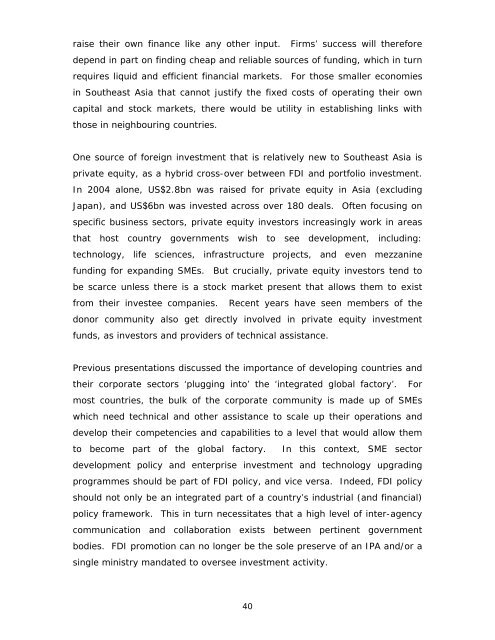(EGM) Foreign Direct Investment in Southeast Asia - Unido
(EGM) Foreign Direct Investment in Southeast Asia - Unido
(EGM) Foreign Direct Investment in Southeast Asia - Unido
You also want an ePaper? Increase the reach of your titles
YUMPU automatically turns print PDFs into web optimized ePapers that Google loves.
aise their own f<strong>in</strong>ance like any other <strong>in</strong>put. Firms’ success will therefore<br />
depend <strong>in</strong> part on f<strong>in</strong>d<strong>in</strong>g cheap and reliable sources of fund<strong>in</strong>g, which <strong>in</strong> turn<br />
requires liquid and efficient f<strong>in</strong>ancial markets. For those smaller economies<br />
<strong>in</strong> <strong>Southeast</strong> <strong>Asia</strong> that cannot justify the fixed costs of operat<strong>in</strong>g their own<br />
capital and stock markets, there would be utility <strong>in</strong> establish<strong>in</strong>g l<strong>in</strong>ks with<br />
those <strong>in</strong> neighbour<strong>in</strong>g countries.<br />
One source of foreign <strong>in</strong>vestment that is relatively new to <strong>Southeast</strong> <strong>Asia</strong> is<br />
private equity, as a hybrid cross-over between FDI and portfolio <strong>in</strong>vestment.<br />
In 2004 alone, US$2.8bn was raised for private equity <strong>in</strong> <strong>Asia</strong> (exclud<strong>in</strong>g<br />
Japan), and US$6bn was <strong>in</strong>vested across over 180 deals. Often focus<strong>in</strong>g on<br />
specific bus<strong>in</strong>ess sectors, private equity <strong>in</strong>vestors <strong>in</strong>creas<strong>in</strong>gly work <strong>in</strong> areas<br />
that host country governments wish to see development, <strong>in</strong>clud<strong>in</strong>g:<br />
technology, life sciences, <strong>in</strong>frastructure projects, and even mezzan<strong>in</strong>e<br />
fund<strong>in</strong>g for expand<strong>in</strong>g SMEs. But crucially, private equity <strong>in</strong>vestors tend to<br />
be scarce unless there is a stock market present that allows them to exist<br />
from their <strong>in</strong>vestee companies. Recent years have seen members of the<br />
donor community also get directly <strong>in</strong>volved <strong>in</strong> private equity <strong>in</strong>vestment<br />
funds, as <strong>in</strong>vestors and providers of technical assistance.<br />
Previous presentations discussed the importance of develop<strong>in</strong>g countries and<br />
their corporate sectors ‘plugg<strong>in</strong>g <strong>in</strong>to’ the ‘<strong>in</strong>tegrated global factory’. For<br />
most countries, the bulk of the corporate community is made up of SMEs<br />
which need technical and other assistance to scale up their operations and<br />
develop their competencies and capabilities to a level that would allow them<br />
to become part of the global factory. In this context, SME sector<br />
development policy and enterprise <strong>in</strong>vestment and technology upgrad<strong>in</strong>g<br />
programmes should be part of FDI policy, and vice versa. Indeed, FDI policy<br />
should not only be an <strong>in</strong>tegrated part of a country’s <strong>in</strong>dustrial (and f<strong>in</strong>ancial)<br />
policy framework. This <strong>in</strong> turn necessitates that a high level of <strong>in</strong>ter-agency<br />
communication and collaboration exists between pert<strong>in</strong>ent government<br />
bodies. FDI promotion can no longer be the sole preserve of an IPA and/or a<br />
s<strong>in</strong>gle m<strong>in</strong>istry mandated to oversee <strong>in</strong>vestment activity.<br />
40

















